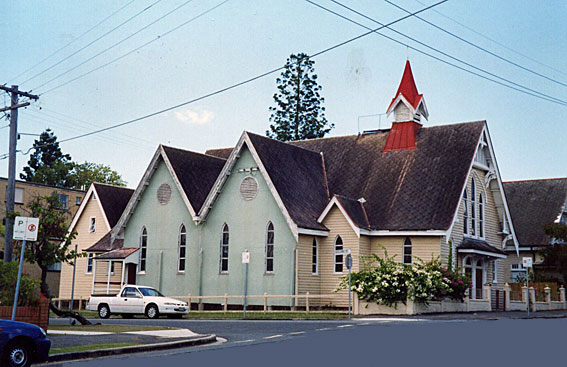
Mowbraytown Presbyterian Church, East Brisbane
[Photograph by Geoffrey Cox (January 2004)]

Mowbraytown Presbyterian Church, East Brisbane
[Photograph by Geoffrey Cox (January 2004)]
Historical and Technical Documentation by Geoffrey Cox
© OHTA 2010, 2016 (last updated May 2016)
The Mowbraytown Presbyterian Church was opened in 1885, commemorating the name of the 'Father' of Presbyterianism in Queensland, Rev. Thomas Mowbray, who arrived in Brisbane in 1847 and established a Presbyterian congregation in 1849. They built their first church in Grey Street, South Brisbane in 1851,1 and the Mowbraytown congregation stemmed directly from the South Brisbane congregation.
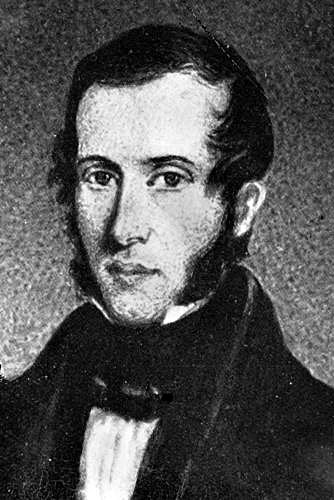
Reverend Thomas Mowbray
[Photograph: John Oxley Library, State Library of Queensland]
The Mowbraytown church was designed by the Scottish-born architect, Alex B. Wilson. Transepts were added to the building in 1899 and 1909.2 The church was closed in December 1992 and sold in 1995.3 It has since been occupied by a succession of businesses, but the organ, pulpit and surrounding church fittings have been preserved. The building has been occupied since April 2009 by "BCA Consultants".4
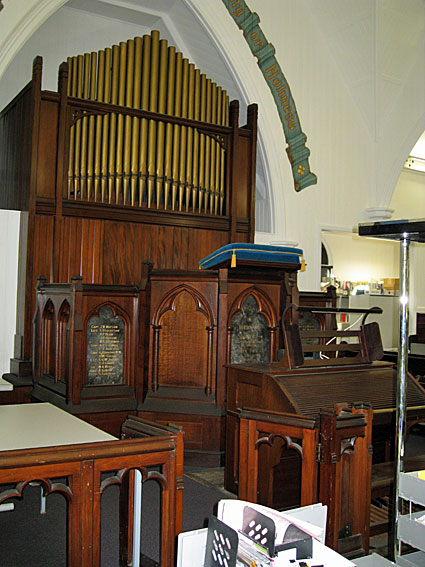
Former Mowbraytown Presbyterian Church, East Brisbane
Organ, pulpit and console preserved
[Photograph by Geoffrey Cox (April 2009)]
The original organ was supplied by Charles Richardson of Sydney, and installed around February-March 1902. The purchase cost was £120, and Richardson was paid a further £12 to erect it in the church, where it was located at the back of the building.5 An organ recital and concert was advertised for 6 March 1902 in connection with the new organ:
COME and hear the Organ Recital and Concert,
Mowbraytown Church, Thursday, 6th March: new pipe organ.6
The opening was described fully in The Brisbane Courier two days later:
A NEW ORGAN.
The Mowbraytown Presbyterian Church on Thursday night formally opened its new pipe organ. The old one (which has done yeoman service to the Church since its inception) was an American organ, presented by the late Mr. Gilbert Lang. Rather more than a year ago the congregation decided that a larger instrument was necessary, and negotiations were opened, the result being the fine instrument now in the church. The following is the specification:- Manual CC to F, 54 notes ; open diapason, 8ft.; stop diapason, 8ft.; gamba, 8ft., principal, 4ft.; flute, 4ft; pedal CCC to C, 25 notes ; bourdon, 16ft. The mechanical accessories are :- Two composition pedals, coupler, great to pedal, and tremulant.
The manual pipes are all enclosed in a swell box, except the open diapason, the lower portion of which forms a speaking front. The appearance of the instrument is quiet though dignified, the silvered pipes being relieved by the dark polished woodwork. The tone of the individual stops is very good, particularly the gamba and bourdon, while the effect of the complete organ, though not too loud, is full and bright. The builder of the organ is Mr. C. Richardson, Sydney. The opening on Thursday took the form of an organ recital by Mr. E. F. Dingle, organist of the City Tabernacle. The pieces selected by him were "March from Athalie" (Mendelssohn), "Hymn of Nuns" (Wely), "Serenata" (Braga), and "Marche Triomphale" (Lemmens). The second and third of those showed to advantage the softer combinations of the instrument, while the full power was admirably displayed by the first and last. The soloists for the evening were Miss Watt (soprano), Mr. Hammond (baritone), and Mr. A. J. Yorston (cornet), and, needless to say, the solos were all rendered with excellent taste. The Church choir contributed two numbers, under the baton of the organist of the church (Mr. H. A. Yorston). The choruses were both well rendered, "Sweet and Low" (Barnby) in particular being sung with good effect of light and shade.7
Richardson appears to have established connections with several Presbyterian churches in Queensland around this time: he had installed an organ built by his father's firm (W.E. Richardson & Sons of Manchester) at St Andrew's Presbyterian Church, Rockhampton in 1900, and his organ for the Ann-Street Presbyterian Church in Brisbane was completed in 1903. The specification of the Mowbraytown organ was the most modest of the three:
| MANUAL Open Diapason Gamba Stopped Diapason Principal Flute PEDALS (C to C) Bourdon COUPLER Manual to Pedal |
8 8 8 4 4 16 |
[pipes marked "mixture"] [Ten. C] [Stopped Bass, then Chimney, then Open] |
Mechanical action
Compass: 54/25
Pedalboard: straight
2 combination pedals.8
In addition to the above details, Mr E.R. Salisbury recorded that there was a tremulant, operated by a knob under the keyboard on the right. He also reported that the Pedal Bourdon was thought to be "over 200 years old".9 This, together with the reported markings on the Open Diapason (see above), suggests that some parts of the organ may have been second-hand, but there is little doubt that Richardson was the builder. Not only do the church records refer to payments to "the builder, Mr Richardson",10 but the posts, rail, decorative braces and paneling on the central part of the present case closely resemble those on at least two other single-manual organs built around the same time by Richardson for churches in New South Wales: St Paul's Anglican Church, Carcoar (c.1900)11 and St Aidan's Anglican Church, Blackheath (1902).12
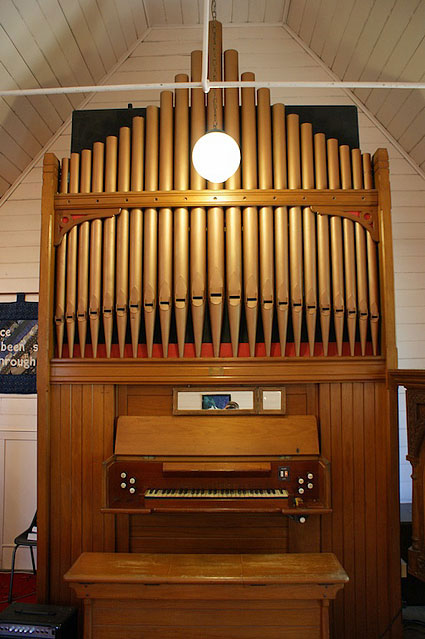
The 1902 Richardson organ at St Aidan's Anglican Church,
Blackheath, New South Wales
[Photograph by Rodney Ford (1995)]
The East Brisbane organ appears to have been very slightly larger than the two mentioned above, apparently with five stops on the manual and a pipefront containing 25 pipes. It resembled the instrument at Blackheath in its inclusion of a Pedal Bourdon, although it seems to have lacked an Octave Coupler. The position of the tremulant at Blackheath (operated by a knob beneath the console) appears to resemble its reported position at Mowbraytown. It is likely that the [Stopd.] Diapason was divided at Tenor C, as it was in the other two instruments. The organ appears to have remained much as Richardson built it for some four decades, except that an electric blower was supplied in 1925 at a cost of £78.13
The Mowbraytown instrument was enlarged and rebuilt with tubular-pneumatic action in 1940-41 by Whitehouse Bros of Brisbane at a cost of £598.14 The original pipework was incorporated into the present organ, spread over two manuals. The stop-keys are Wurlitzer-type stop-tongues, like those on the extension organ installed nearby in 1942 at the Church of England Grammar School ('Churchie'). In the latter instance, these came from the roll-playing unit of the Wurlitzer theatre organ in the Wintergarden Theatre, Queen Street, Brisbane, and it is likely that the Mowbraytown stop-keys are of the same origin.
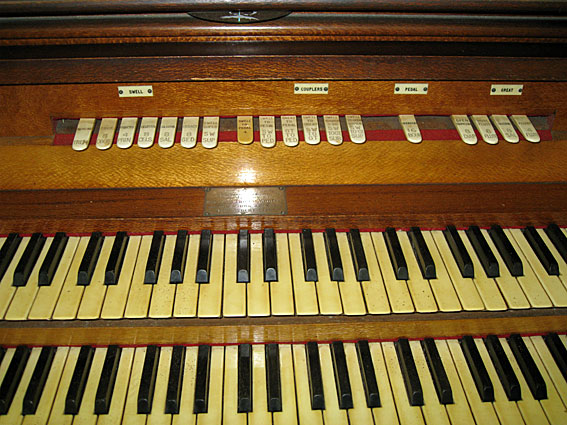
Console at Mowbraytown after the rebuilding and enlargement
of the organ in 1940-41 by Whitehouse Bros of Brisbane.
[Photograph by Geoffrey Cox (April 2009)]
A Swell to Pedal 4' coupler was added in June 1946 at a further cost of £40,15 and a plaque on the console reveals that it was dedicated to the memory of William Thomas Woolley by his widow and sons in August that year.16 A new electric blower was supplied in June 1951.17 The tubular-pneumatic action was completely restored in 1972 by H.W. Jarrott of Brisbane.18 The organ has been preserved intact since the closure of the church in 1992.
| GREAT Open Diapason Hohl Flute Salicional Flute SWELL Gedact Salicional Celestes Principal Oboe PEDAL Bourdon COUPLERS Swell to Great Swell to Pedal Great to Pedal Swell to Pedal 4' Swell Super Swell to Great Sub Swell to Great Super. |
8 8 8 4 8 8 8 4 8 16 |
[1902 or earlier] [1941] [duplexed from Swell] [1902] [1902] [1941] [1902 Gamba] [Ten. C] [1902] [1941] [1902 or earlier] [1946] |
[Swell] Tremulant
Tubular-pneumatic action
Detached stop-key console
Balanced Swell Pedal
Compass: 61/30.19

[Photograph by Geoffrey Cox (September 2010)]
________________________________________________________________________
1 Richard Bardon, The Centenary History of The Presbyterian Church of Queensland (Brisbane: W. R. Smith & Paterson, 1949), pp. 19-21, 217, 243, 247.
2 Queensland Heritage Council, Queensland Heritage Register, location 601219; Donald Watson & Judith McKay, Queensland Architects of the 19th Century: A Biographical Dictionary (Brisbane: Queensland Museum, 1994), pp. 208-10.
3 Personal communication to G. Cox from George Nelson (Organist), 1995.
4 http://www.bcaconsultants.com.au - accessed April 2010.
5 Information from Minutes of the Committee of Management of Mowbraytown Church, 13 Feb & 13 March 1902, supplied by David Nisbet (Session Clerk), 1974.
6 The Brisbane Courier (5 March 1902), p. 10.
7 The Brisbane Courier (8 March 1902), p. 14.
8 Original specification supplied by E.W.T. Johnston (former organist), January 1974.
9 Notebooks of Edward R. Salisbury, presumably recorded before 1941.
10 Minutes of the Committee of Management, op. cit.
11 Drawing by Graeme Rushworth in OHTA Conference Booklet, 2010.
12 Details of the Blackheath instrument are given in Graeme Rushworth, Historic Organs of New South Wales: The Instruments, Their Makers and Players 1791-1940 (Sydney: Hale & Iremonger, 1988), p. 128; Details of the Carcoar instrument, supplied by Kelvin Hastie, are given in the OHTA Conference Booklet, 2010.
13 Whitehouse Bros Ledger (1922-1940), p. 113.
14 Whitehouse Bros Ledger (1940-1954), p. 313.
15 Whitehouse Bros Ledger (1940-1954), p. 431 (listed under "Mrs W. Woolley, 63 Latrobe St, E. Bris.")
16 Plaque cited by G. Cox, 2009.
17 Whitehouse Bros Ledger (1940-1954), p. 693.
18 Personal communication to G. Cox from H.W. Jarrott, c.1973.
19 Specification noted by G. Cox, 1973 & 2009; Derivations from old organ supplied by E.W.T. Johnston (organist at the time of the 1941 rebuild), January 1974.